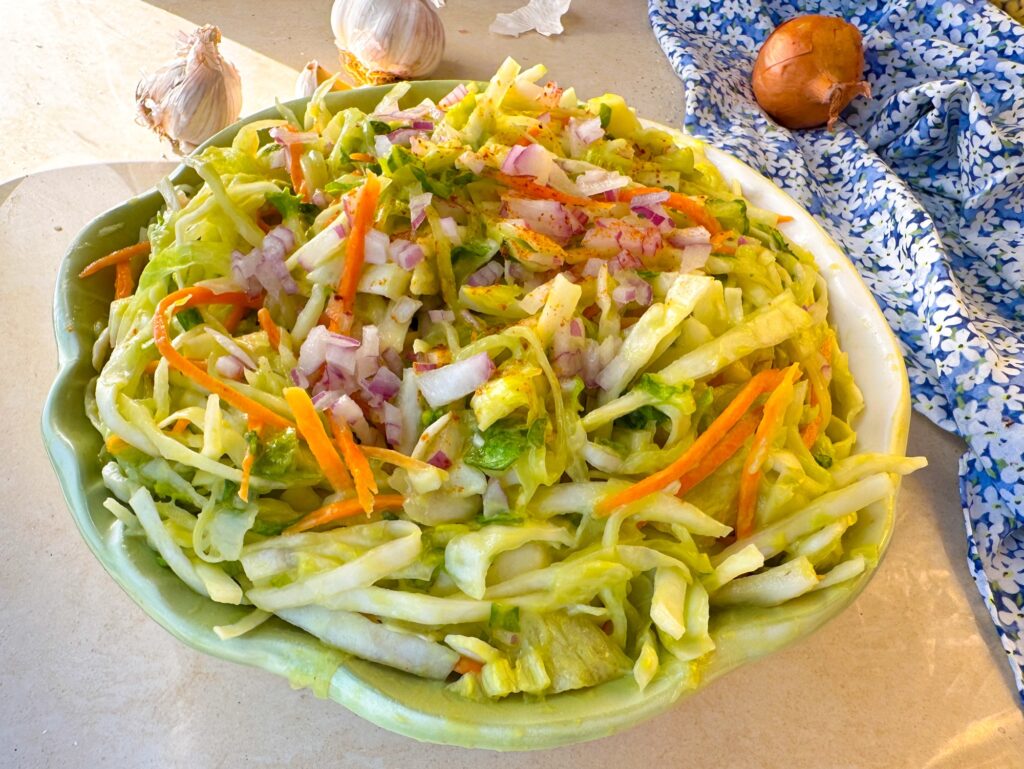Many of my group participants tell me it’s hard for them to eat raw dinners and very tempting to have a cooked meal instead, especially after a tiring day of work. I think that’s perfectly fine to eat a cooked dinner and can be very healthy.
At the same time, if you find that eating a raw dinner or adding a big salad to your cooked meal makes you feel better the next morning, I invite you to explore the world of satisfying raw or high-raw vegan dinners with me.
I also encourage you to try having dinner 2-3 hours before bedtime and see how you feel. Personally, when I eat earlier, I sleep much better and wake up feeling lighter and more refreshed.
The simplest and quickest raw vegan dinner is, of course, a large salad with a hearty dressing and other delicious toppings. But how can we make it just as satisfying as a cooked meal?

Unless you’re on a fat-free cleanse, I recommend using 4-8 tablespoons of soaked nuts, seeds, or avocado in your salad dressing—this amounts to about 10%-20% of your daily calories on a 2,000 kcal diet. If you’re on a fat-free cleanse, a fruit-based dressing can also be quite satisfying.
A delicious, creamy dressing is key to a satisfying salad. It’s also important to balance the omega-6s from avocados, nuts, and most seeds with anti-inflammatory omega-3s. This keeps your digestive system calm and comfortable, avoiding the inflammation and discomfort we often mistake for hunger.
A juicy salad is more satisfying because hydration plays a huge role in controlling appetite. Cucumbers, tomatoes, bell peppers, and juicy lettuce varieties like iceberg or Romaine are excellent for deep cellular hydration.
One of the biggest secrets to making raw vegan dinners satisfying is understanding that raw veggies are much lower in calorie density and much higher in water content.
Salads are also fluffy, with lots of air between the leaves. This means you need to eat much larger portions than you would with cooked food to feel satisfied. You can try blending a salad to see how much it shrinks down—after that, you won’t be afraid to eat a huge salad anymore!

Denser root vegetables like raw beets, carrots, and sweet potatoes can fill you up faster than fluffier, “above-ground” veggies. If you find root veggies harder to digest, try blending them with a bit of avocado, nuts, or seeds.
When creating your dressing, aim for a mix of root vegetables, juicy above-ground veggies, and a handful of nuts or seeds—10%-20% of your calories from fat is ideal.
You can make your salad more exciting by trying different chopping techniques—shredding, julienne peeling, spiralizing, or using a food processor. Feel free to add your favorite spices or herbs. A little salt can enhance your meal—there’s no need to fear a small amount of unprocessed, non-iodized sea salt (up to 1/2 teaspoon). A little salt can improve digestion, keep you satisfied, and help avoid cravings for unhealthy salty snacks.
For an extra satisfying and nourishing touch, try adding raw mushrooms, such as champignon, shiitake, or portobello. I don’t recommend eating them fresh because of their strong aftertaste, but marinating or dehydrating them removes the aftertaste and makes them much more enjoyable.
Sprouts are a fantastic addition to your salads if you are looking for a satisfying raw vegan protein source. If you want garbanzo beans, mung beans and lentils to be softer, you can freeze and defrost them after sprouting. Small sprouts like alfalfa, arugula, broccoli, etc. are already quite soft, juicy and very delicious in any salad.
Seaweeds like nori sheets and dulse are another secret to a satisfying raw vegan salad.
However, when using kelp, I suggest doing so sparingly—too much iodine can throw your system out of balance.
You can also elevate your salad by sprinkling crushed flax crackers on top. If you’re concerned about extra fat, you can make your crackers primarily from vegetables, adding just a small amount of flax or chia seeds.

Another tip: if you make a batch of raw vegan wraps once a week, you can easily transform your salad into a real treat by wrapping it up. This is perfect for work or a picnic.
Alternatively, you can wrap your salad in iceberg leaves, Romaine, collard or something similar.
For an extra nutrient boost, you might add spirulina, chlorella, or green powders like Vitamineral Green—these are nutrition powerhouses.
If you decide to include some cooked food for dinner, I recommend starting with a fresh salad. Even if you don’t feel like making a dressing, a small salad can help your body absorb more nutrients. As you transition to more raw foods, you can gradually increase the amount of salad while decreasing the cooked portion.
For cooked meals, I suggest steamed veggies, potatoes, or sweet potatoes. Remember, lower cooking temperatures are better—high heat can create unhealthy compounds like acrylamide.
Add fresh veggies to your cooked meal and aim for 10%-20% of your calories from fat. I also recommend avoiding oil, as it lacks nutrients, and be mindful of gluten-containing foods—they can be quite addictive.
I hope this gives you some delicious ideas for your dinners! I look forward to sharing more recipes and tips with you soon.
Speaking of delicious meals, I’d love to invite you to join us at our upcoming raw vegan retreat in Las Palmas de Gran Canaria. We’ll be making these types of dinners together, and I can’t wait to share this experience with you.
You can find out all about our retreat here: https://www.thewholelifestyle.com/urban-raw-vegan-retreat/


Recent Comments